
A lot goes into writing a valuable blog post. Hours of research. Drafting and drafting and re-drafting.
Editing, grammar checks, search engine optimization.
The work piles up until the point you hit publish. Then, the worst sound in the world: Crickets.
No one’s reading your post.
What went wrong? It’s not that your blog isn’t valuable to your readers. It’s that if people can’t see that value, no amount of work is going to draw your audience.
There are reportedly 600 million blogs worldwide. The moths-to-a-flame strategy doesn’t work when readers see nothing but flames everywhere they look.
How do you get your blog to make noise? Here’s how to address your readers’ pain points, where to push your latest posts, and a few steps to build your own following as you go:
How to promote your blog
Assuming your blog already delivers the goods for your readers, we’re left with two questions: how to promote your blog, and where. We’ll start with how. These are the strategies you need to build an attractive, engaging blog presence online.
Strategy #1: Start with effective SEO
Search engine optimization is the art of prepping your blog posts for preferential spots in popular sites like Google and Bing. And while title tags and meta descriptions still matter, you first have to answer deeper questions.
For starters: who are the people searching for a blog like yours? What are they thinking about?
Finding the answers your audience is looking for
Everyone has pain of some sort. Your job, as a blogger, is to apply salve to that pain.
AWeber user Michele Fralla, for example, hosts a travel blog. Doesn’t sound very painful. But one look at Michele’s blog, The Intrepid Guide, tells you she’s solving all sorts of readers’ problems:
- Learning key phrases to avoid being tongue-tied
- Forging real connections with locals
- Avoiding tourist traps
The pain of Fralla’s readers is fear: the possibility they won’t make the most out of their next trip to Italy.
And that’s the most fundamental concept in SEO. User intent. User intent is the art of discovering the emotion behind search queries.
When someone types in a search query, it’s because some sort of problem or pain moved them to action. It could be as harmless as curiosity, sure. But it could be something deeper.
As Moz notes, search engines like Google place a premium on matching their results to user intent. “When a user searches for a specific term and finds irrelevant information,” writes Moz, “that sends a signal back to Google that the intent is likely mismatched.”
And Google doesn’t like mismatches.
For example, if someone searches “quick low-carb recipes,” are they looking for a quick list of recipes? A quick list…including long, simmering, takes-all-day-to-prep recipes?
No. They want the recipes to be quick. Your blog post should cater accordingly.
When you glance at the results for “quick low-carb recipes,” you’ll see that’s exactly what the top placements do.
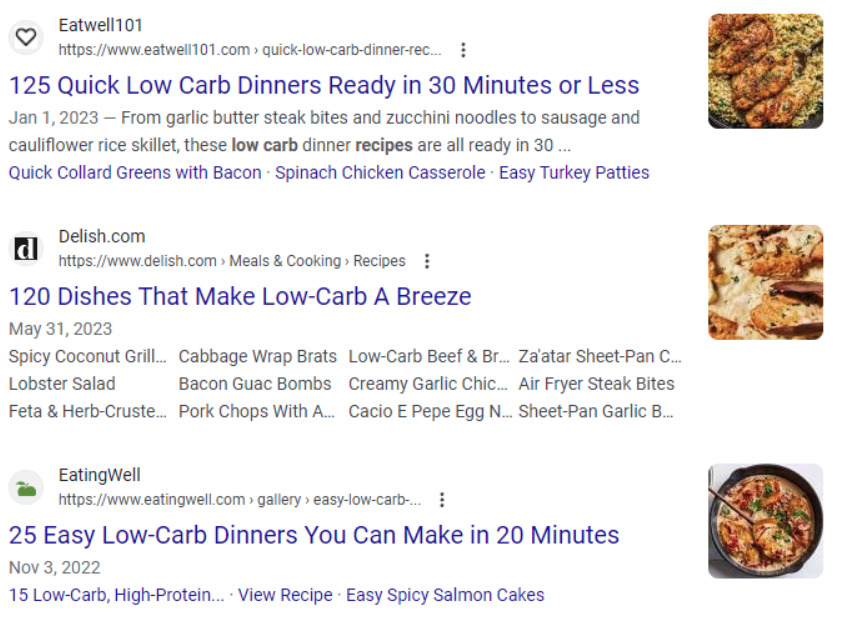
How, then, do you discover search intent? Start with the widest portion of your funnel—the big, most ambitious keywords for which you could ever imagine ranking. Then enter those into Google’s query bar.

You’ll notice similar suggestions. The second suggestion here— “15-minute low-carb meals—gives you the obvious hint.
People don’t want quick tips. They want quick meals.
You can use the same exercise for any niche. Open a spreadsheet and brain-dump the broadest key terms in your niche. In the next column, use Google Suggest to find out what else people are searching for.
Let’s try another one: “finance tips.”
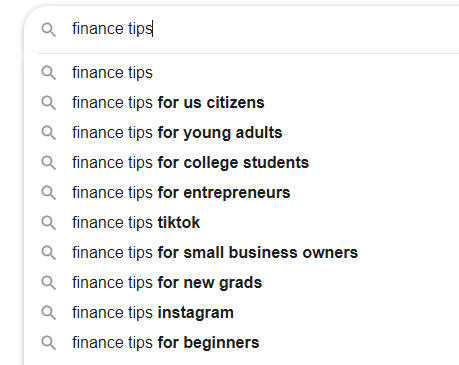
You’ll immediately notice how you can break things down for your audience.
A post on “finance tips for 20-somethings” is going to serve a completely different user intent than “finance tips for retirees.” One audience is looking for help opening their first brokerage account. The next audience is wondering where they can find good property values on the Gulf Coast.
Once you know which user intent you want to serve, try a search. Look around. What other posts have a prominent placement?
You’ll likely see they’re addressing specific pain points. If they are, write those pain points down. You now have fodder for your blog.
But if you can’t find an obvious pain point, maybe there’s an opportunity there. Can you do these posts one better? Can you answer user intent with even more relevance?
Rather than writing “five finance tips to learn in 2023,” maybe you’ll end up with “five investing tips for graduates fresh out of college.”
If this topic feels too specific to generate interest, keep something in mind. It’s better to be the first or second listing on a smaller keyword than the seventy-eighth listing on a bigger one.
In fact, moving from the second page to the first will give you a 143% boost in search engine traffic.
Don’t try to conquer Google overnight; that won’t work. Start by building relevance to user intent.
Take Paula Rizzo, a productivity and media blogger. Those are big categories with huge audiences.
To attract attention, however, she’s specific about solving her audience’s problems. In one webinar, for example, she helps professionals feel better about appearing on camera.
That’s creating a salve for the specific pains of her audience. And it’s the reason it’s so easy to find Paula Rizzo’s tips online. They’re relevant, on-point, and address specific audience questions.
Elements of successful on-site SEO
Dialing into user intent is just part one. There’s a second audience you have to think about: search engine bots.
Search engines are a complicated, intermingled language of algorithms, user behavior, and the digital content of every website. If you want a truly “optimized” blog, you have to know how to speak this language.
- Choose a primary target keyword/phrase for every post and page on your blog. Ideally, you’ve done this work already in the previous section. That’s where user intent and blog post content should fit hand-in-glove.
- Write a snappy headline with the keyword included. The sooner you get to your keyword, the better. Go through a few headline drafts, too—you can use this headline analyzer tool for assistance.
- Create visual content to go with your keywords. “Search engines like Google value visuals for certain keywords,” writes HubSpot. Use free tools like Canva to create flow charts or explanatory graphs to nail your key points home.
- Optimize meta tags. Yes: meta tags! Search engines still appreciate context and descriptions—and so do readers. HubSpot even mentions that search engines have lengthened their meta tag standards to add more vivid descriptions of what users can expect from a link.
- Install analytics. Tools like Google’s Search Console will provide invaluable insights. What are the top-performing pages on your site? Now you know what’s clicking with your audience. You’re free to lean into that content for even more SEO success.
If you also use Google Analytics, you’ll have even more insights. Look at the links that drive the most traffic, and think back to user intent.
Are there specific pain points that your most popular posts are solving? Are there other pain points that you hadn’t even considered?
Ultimately, getting traffic to your site via SEO is just as much art as it is science. It requires imagination and empathy for your readers. It requires a little bit of razzle-dazzle to entice search engine users to click through.
But if you address both the on-site and psychological elements of SEO, you’ll build a stickier, more attractive blog. Over time, your search engine results will be the payoff for all that hard optimization work.
Even so—what if you want to give your blog more of an instant shot in the arm?
Strategy #2: Social Media
SEO is a tool for bringing people to you, long-term.
But if you want an influx of traffic this instant, you’ll have to go where the people are. That means an encounter with those two words that have changed the world: social media.
Repurposing content for social media
Do you already have a valuable blog? Is the primary problem that you can’t get enough eyeballs on your content?
Then repurposing that content for social media is the shortest distance between you and the blog traffic you want.
Look at your most successful content—measured by clicks—and turn that post into a new document. Chances are, it’s full of valuable insights and information people in your social media circle would love to see. Here’s how to promote a blog by showing off your content on social media:
On LinkedIn, you can create blog posts directly from your original piece. In fact, that’s the exact strategy Brian Dean of BackLinko used. “I literally copied the exact post word-for-word,” writes Dean.
LinkedIn status updates generally give you more slack. You can share entire posts without a link. That might seem counterintuitive from a blog-promotion standpoint, but if a post goes viral, you’ve expanded your reach.
Even better, you can earn a reputation for thoughtful content on LinkedIn simply by repurposing already-written material. There’s little extra work.
On Twitter, you have a couple of options:
- Turn long-form posts into individual tweets. Tools like WordOut are great at taking long-form content and using AI to decipher the most viral-ready blurbs and quotes. Once again, there’s minimal added work on your end.
- Turning posts into Twitter threads. How did Aytekin Tank get 17 million impressions from a blog post? By repurposing a Medium post into a Twitter thread, where the content immediately went viral. That led to 35,000 visits back to the original post.
Don’t do everything manually, either. Use tools like Tweet Hunter and HypeFury to make repurposing much easier to handle with copy, paste, and a few clicks.
On Facebook, the name of the game is to “stop the scroll.” Give the average Facebook user a reason to stop in their tracks.
Here’s how to get them to think: hey. That looks interesting…
- Create visual content with blog-specific “header” images. You can use manual or AI tools that can help. Canva even offers Facebook header templates to make your posts stand out.
- Write a compelling “hook.” The hook is the first sentence, and it works as a fishing metaphor because you hope people bite on it. Once again, address your audience’s primary pain point here. They should think: “Yes, I have that problem—how do I solve it?”
Automating Your Social Media Output
At this point, your eyes might be glazing over. Learning how to promote a blog is starting to sound like a lot of work.
But it doesn’t have to be. Automation tools can handle social media promotion on your blog’s behalf. You just need to know how to plug them in, so to speak.
For starters, you can use a service like Zapier to link your blog content with your social media accounts. Just glance at their WordPress connections and you’ll see how easy it is to cross-post new links to Twitter, LinkedIn, and Facebook—without lifting a finger.
You can also hook up AWeber to your latest posts, using AWeber’s blog automation to send a post to your entire audience the moment it’s published.
If you’ve gathered a large audience on social media or via email, you’ll get eyes on your new content almost the instant you hit “publish.”
Joining niche-relevant communities to boost engagement
All the above sounds great. But what if you only have 15 followers?
You can still promote your blog on social media by taking a more proactive approach. You can’t always lead a horse to water…but you can go find a whole bunch of horses.
Find the communities and start posting
Don’t trust people to find you. Go meet them on their terms. To do this, you’ll have to find communities within your niche and then visit the social media platforms that host them. You have a few options here:
- Reddit communities: Reddit is essentially a social media board that contains millions of mini-social boards. True, it can be hard to self-promote your links without an established account. But if you’re an active participant in a subreddit, you’ll get away with providing helpful posts—even if they’re yours.
- LinkedIn groups: Lots of people joined LinkedIn with the idea of networking. That means professional groups—typically built around common interests or markets. You can share posts directly to those groups to get some extra eyes on your content.
- Twitter engagement groups: Sometimes, novices on Twitter have to build engagement from the ground up. That means joining Discord communities and other Twitter engagement groups where the idea is simple: promoting each other. It’s not a guarantee of success, but it could accelerate your progress.
Borrow engagement from high-profile accounts
Communities are a good start. But people with big audiences essentially have their own community followings—and you can use those for promotion, too.
The idea is to “borrow” someone else’s audience. Comment on larger social media accounts with some helpful tips of your own. Tell a joke occasionally.
If 1,000 people see your helpful-and/or-pithy comment, it can drive more traffic to your user profile than 100 views on an otherwise helpful post on your main profile. And those profile visitors check out your feed to see if everything else you say is as valuable as that comment they spotted.
You don’t have to limit this outreach to social media, either. You can write guest posts on popular blogs to drive traffic back to your own, extending your reach as well as your SEO footprint.
Where to promote your blog
We’ve answered how to promote your blog. Now, let’s dive deep into where. Once you’ve established some good content habits, you simply need to know where the people are—and how to reach them.
Strategy #1: Email marketing
Sometimes, it’s more effective to start with email marketing than to build a blog. A blog, after all, is like putting together a novel one chapter at a time.
But if you use a “lead magnet” approach to building your email list and promoting a blog, you only have to build the first piece to start attracting attention.
Take Emma Johnson of the Wealthy Single Mommy blog. She could have started big—a concept like “financial tips.”
But she was writing to a specific user pain point: single parents looking to get control over their finances.
Not only does Johnson write to that audience, but she built an email audience by giving them a free resource: “15 Steps to Thriving as a Single Mom.”
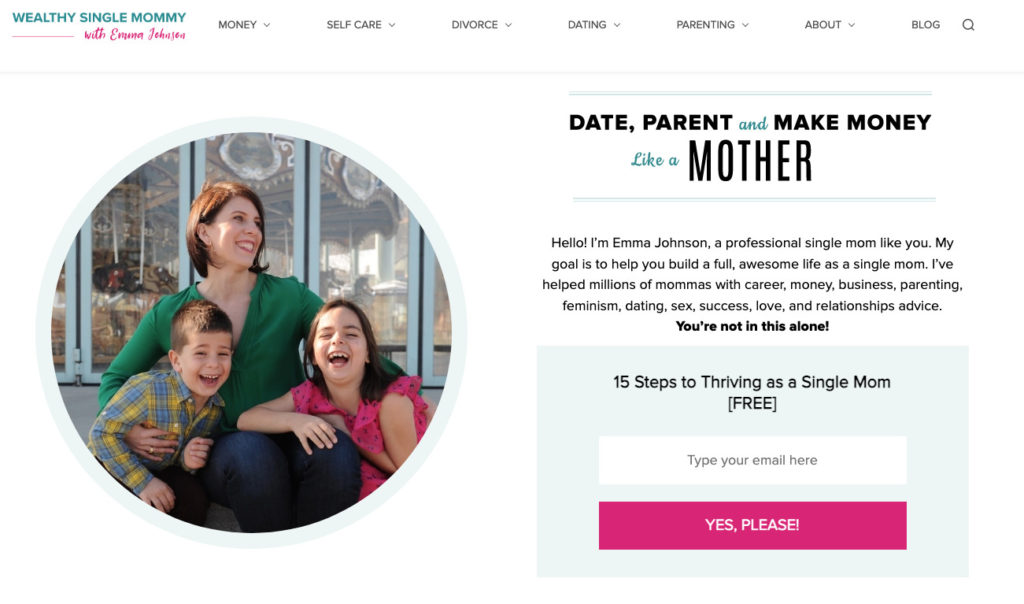
There’s also the implicit promise of “15 steps,” telling the audience exactly what they’ll get out of clicking “Yes, please!”
Strategy #2: Web push notifications
Web push notifications are those short, clickable messages popping up in your Internet browser. Less intrusive than a true “pop-up,” they can encourage those who’ve accepted your notifications to click where you’re nudging them.
The key with push notifications, despite the name, is not to be pushy.
Donna Partow, for example, only uses push notifications to specific segments of her audience when she knows she has helpful tips to share. Otherwise, too many notifications can get distracting in a hurry.
To use push notifications the way they’re intended, set them up to highlight only when there’s something new: tips, for example, or new blog content.
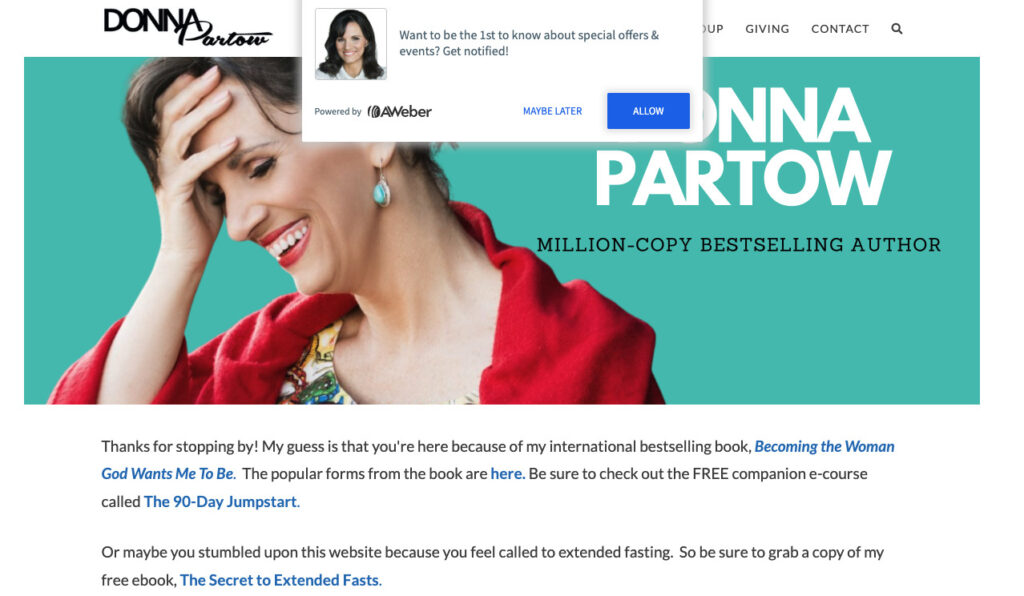
Jennifer Reinhard of “All About Cloth Diapers” uses this strategy. “[My audience] may not read the email or see Facebook posts, but they will see the web push notification because it will pop up on their desktop when they’re online — exactly when they need it,” says Reinhard.
Use AWeber to set up push notifications like Reinhard: only when there’s something new. They’ll feel less promotional and more like a handy “alert” for your audience.
Strategy #3: Join communities on social media
We’ve already tackled places you can seek if you want to make your social media presence more “loud.” But what if that’s not enough?
Woorank recommends joining interactive communities. Think Discord groups, Google Hangouts, and Twitter chats.
The goal with these isn’t to spam links featuring your latest posts. Instead, just build name recognition. Interact with prominent people in your niche and get them used to seeing your name, too.
Strategy #4: Identify guest post opportunities
Search engines are your best friend here.
Let’s go back to finance tips as an example. Maybe you’re new to the niche and want to get your name out there. You like the idea of guest posts—but have no idea how to start.
Go to Google and type “finance blog” in quotes, then “+ write for us.” Or “+ guest posts.” You’ll quickly identify those blogs that invite new contributors—to the point of building their own landing page for it.
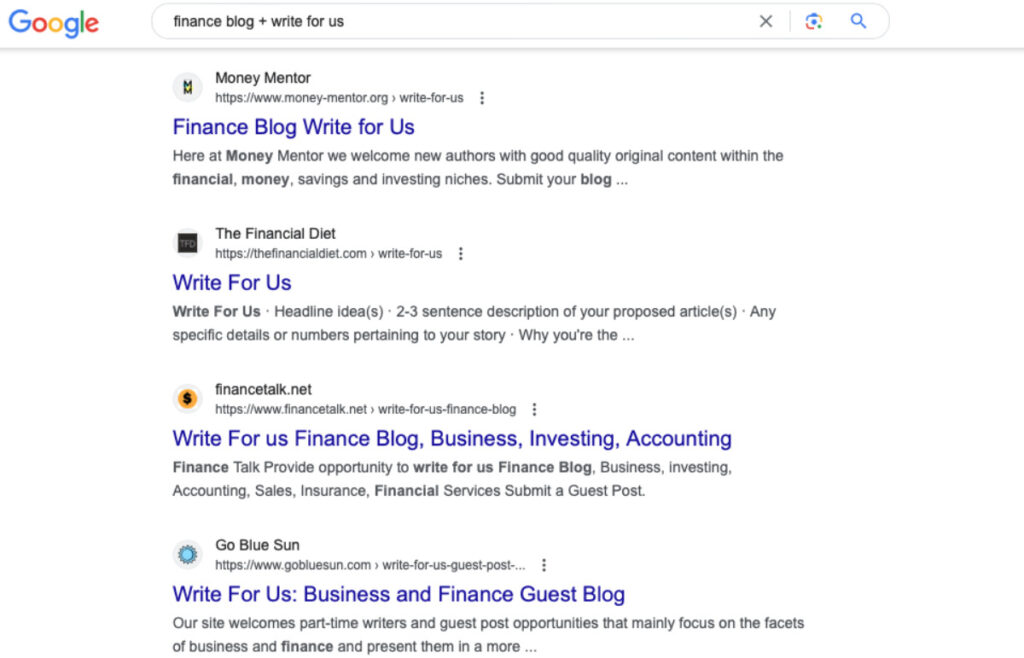
This work will typically be unpaid. But you will get paid with a byline and a link back to your blog—not to mention an opportunity to shine in front of a bigger audience.
If you’re not sure which topics to pitch, try watching those bloggers on Twitter. Review old guest posts. What types of content do they typically post?
When you get the opportunity, approach your new post like it’s the opportunity of a lifetime. It’s going to be featured on a prominent blog, after all, and it’s going to continually speak to the quality that you offer at your blog.
This isn’t just an informational post; it’s an indirect “pitch” for the kind of stuff readers can expect at your own site.
Strategy #5: Treat your blog like a purchase funnel
Back to Emma Johnson for a bit. Notice how naturally her audience fits with her lead magnet. It doesn’t take someone long to land on her AWeber signup page and find out what she’s all about.
And that’s the goal: your blog is like a purchase funnel. Once written, a blog becomes a landing page—an example of the quality of content you produce.
Then, when someone sees that you offer a guide featuring all of your tips in one place, they can’t help themselves. They have to see what other insights you have to share.
So they sign up.
Think of this like a conversion funnel, except there’s no purchase. Conversion is when someone becomes a follower of your content via your newsletter.
Now, every time you produce a new post, you can send it out to the newsletter—getting immediate feedback and attention. Ideally, you’ll create a virtuous circle that continues to grow.
Where and how to promote your blog
Turning your blog from a new one to a popular one can be daunting, and it requires two big pieces: learning how and where to promote it.
The last thing you want to do is create great content, only for no one to ever notice it. But if you dial into the relevant topics for your specific audience and learn how to make more “noise” online, keep at it. People will notice.
And once you do, don’t let that be the end of it. Build a community with your very own email newsletter that attracts sign-ups while you sleep.
Don’t have an AWeber account? Sign up for free and start building your audience from the ground up.
The post How to promote a blog (with strategies and examples from established bloggers) appeared first on AWeber.
from AWeber https://ift.tt/xs2lJbi
via IFTTT
No comments:
Post a Comment